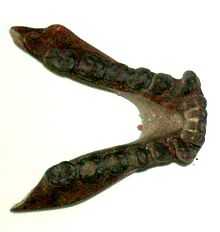Pliopithecus
From Wikipedia, the free encyclopedia
| Pliopithecus Temporal range: Late Miocene - Pliocene | |
|---|---|
 | |
| Mandible fragment of Pliopithecus antiquus from Sansan, France; cast from Museum national d'histoire naturelle, Paris | |
| Scientific classification | |
| Kingdom: | Animalia |
| Phylum: | Chordata |
| Class: | Mammalia |
| Order: | Primates |
| Suborder: | Haplorrhini |
| Infraorder: | Simiiformes |
| Parvorder: | Catarrhini |
| Superfamily: | †Pliopithecoidea |
| Family: | †Pliopithecidae |
| Subfamily: | †Pliopithecinae |
| Genus: | †Pliopithecus Gervais, 1849 |
| Paleospecies | |
| |

Pliopithecus antiquus jaw seen from above
Pliopithecus is a genus of extinct primates of the Miocene and Pliocene. It was discovered in 1837 by Édouard Lartet (1801–1871) in France, with fossils subsequently discovered in Switzerland and Spain.
Pliopithecus' had a similar size and form to modern gibbons, to which it may be related, although it is probably not a direct ancestor. It had long limbs, hands, and feet, and may have been able to brachiate, swinging between trees using its arms. Unlike gibbons, it had a short tail, and only partial stereoscopic vision.[1]
Anapithecus is a close relative and was initially considered a subgenus of Pliopithecus.
References
External links
This article is issued from Wikipedia. The text is available under the Creative Commons Attribution/Share Alike; additional terms may apply for the media files.